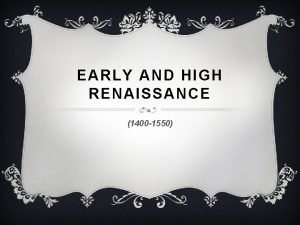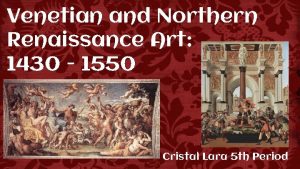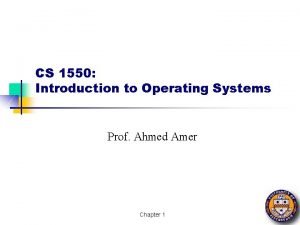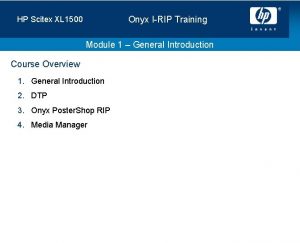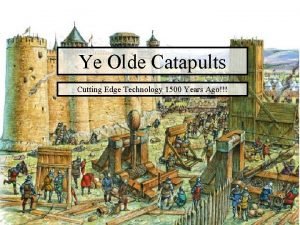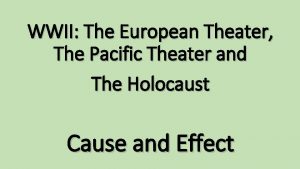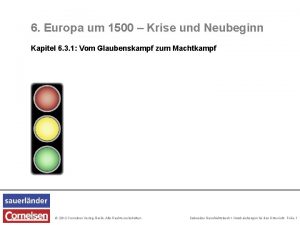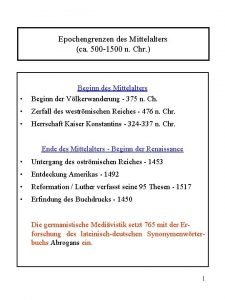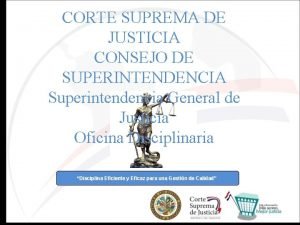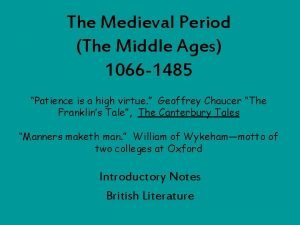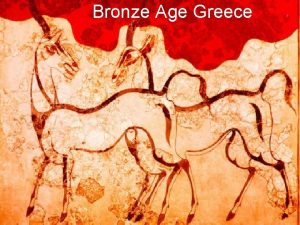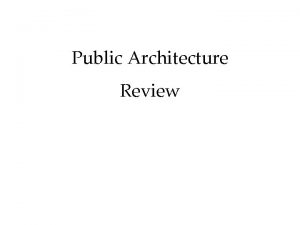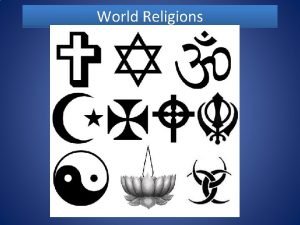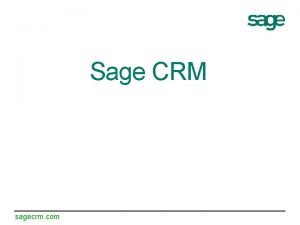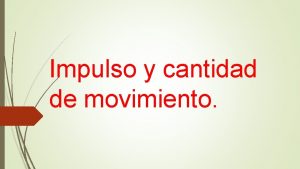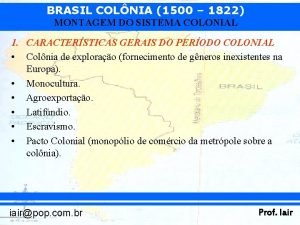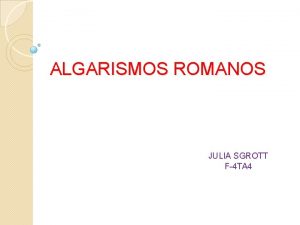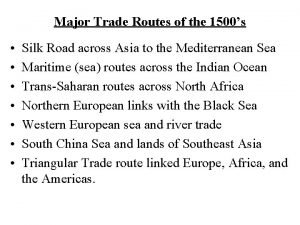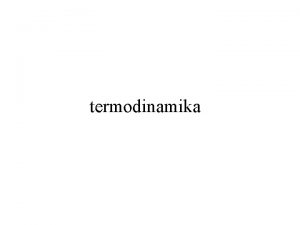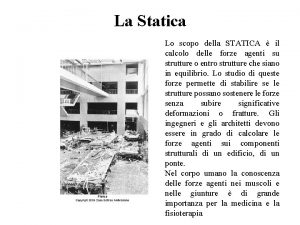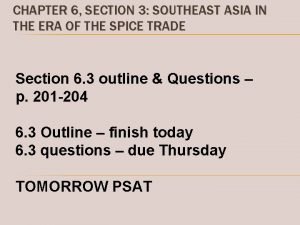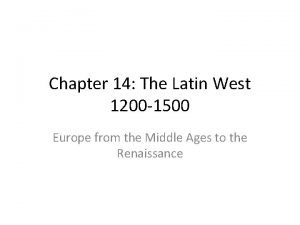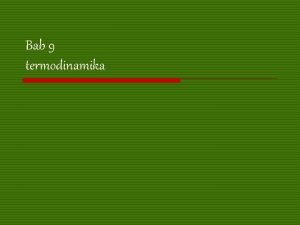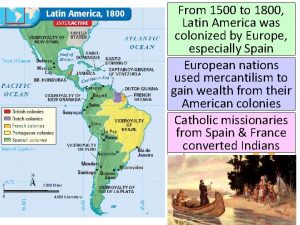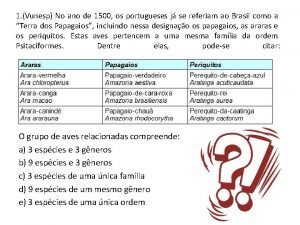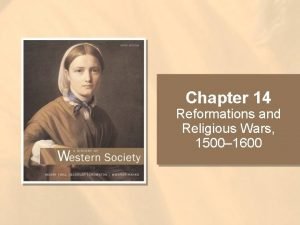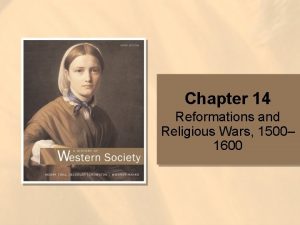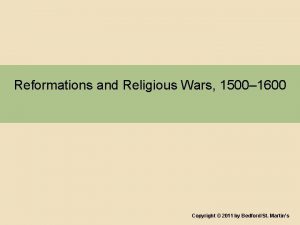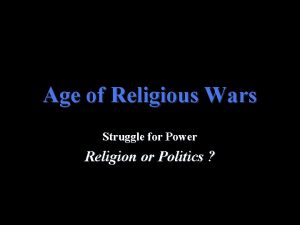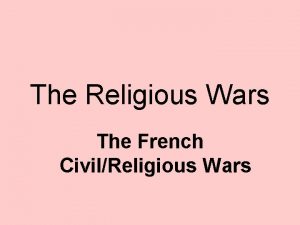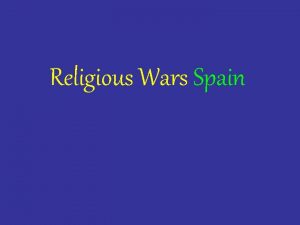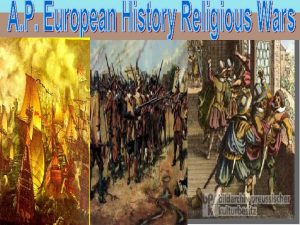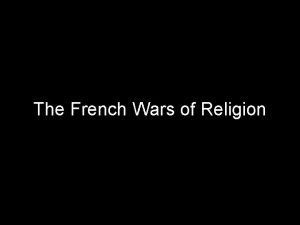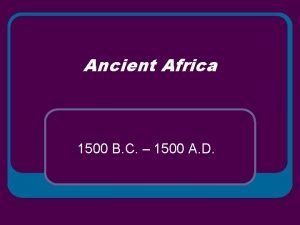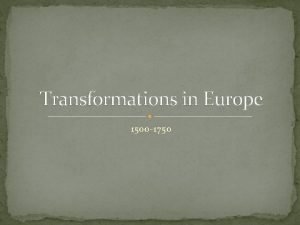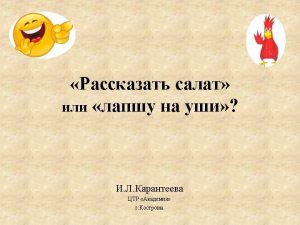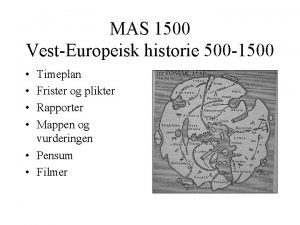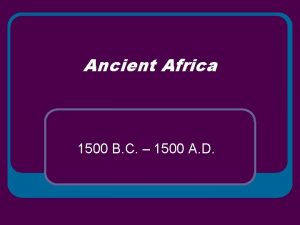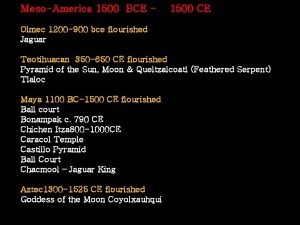Religious Wars Religious Struggle 1500 1550 s struggle










































- Slides: 42

Religious Wars

Religious Struggle • 1500 -1550 s, struggle between Lutherans and Zwinglians (c. Europe) • 1550 s-1600 s, struggle by Calvinists for recognition • Peace of Augsburg – Cuius regio, eius religio – Does not apply to non-Lutheran protestants • Anabaptists, Calvinists as heretics • Religious struggle of Jesuits against Protestants – Protestants have presbyters (boards of elders) in charge of church – Catholics have distinct hierarchy (pope>bishops>priests)

Religious Art • Baroque – Grandiose – 3 D – Raw energy – Ornamental – Typically Catholic • “Plain Church” – Restrained – Gentle – Typically protestant • Why? ?

Baroque • Marries advanced techniques and grand scale of Renaissance to emotion and drama of mannerism • Evokes classical antiquity • Mastery of light to achieve maximum emotional impact • Elaborate furnishings, gardens, art • Sometimes religious








“Plain Church” • • • Restrained Gentle Less grandiose, more realistic to life Calm Rembrandt van Rijn



Syndics of the Draper’s Guild


Politiques • Rulers that subordinate theology to political unity – Religious tolerance – Moderation – Compromise – Indifference – Elizabeth I • Those who stress religion over political unity had persecution toward those of different denominations, including wars – Did not achieve political goals

Struggle for the Crown • Rulers try to impose religion on their own and other nations – Catholic France and Spain declare war on Protestant England Netherlands (30 Yrs War)

Early French Persecution • Huguenots: French protestants • Protestants in France capture French king and plaster anti-Catholic placards around Paris – Leads to mass persecution – Edict of Fontainebleau subjects Huguenots to Inquisition • When Henry II of Fr. is killed, 3 families vie for power: Bourbons, Montomrency-Chatillons, and Guises (Guises gain power) – Guises=militant, reactionary Catholic family (cardinals)

Appeal of Calvinism in France • 40% of Fr. Aristocracy became Huguenots – Aristocracy wants Huguenots to gain power to declare religion of their areas • Thus, political decentralization – To gain political and religious power, Huguenots had to fight back, becoming militant against Catholic church

de Medici and Guises • Catherine de Medici becomes regent for son, Charles IX – Tries to reconcile protestants and Catholics – January Edict: protestants can worship publicly outside/privately inside towns • Duke of Guise massacres worshippers at Vassy, ending royal toleration – Fearing the power of the Guises, Medici submits to them, ending religious toleration • Duke of Guise is assassinated, Medici gives freedoms to Huguenots

St. Bartholomew’s Day Massacre • Medici assists Guises in assassinating Coligny, the head of Huguenots (he survives) – Afraid, Medici convinces king that Protestants are planning a coup under Coligny and that leaders should be killed • August 24, 1572: 3, 000 Huguenots (including Coligny) are killed in Paris – 20, 000 more hunted/killed in France in 3 days • Catholic church celebrates killings • Now a struggle for survival of protestants, not just internal struggle between factions or royal houses • Calvin had taught non-violent submission – Knox encourages it as a Christian duty to depose an unjust, heathen (Catholic) tyrant

Henry III and Henry of Navarre • Henry III – Politique, tries to appease both sides – Peace of Beaulieu (1576): grants Huguenots religious and civil freedom • Forced to repeal Peace in 1577 • Protestants led by Henry of Navarre • Catholic League (Spanish support) wants to take France – Henry III tries to attack League, fails, flees – Assassinates duke and cardinal of Guise – League responds furiously – Henry III allies with Henry of Navarre against Guises – Catholic friar kills Henry III; Henry of Navarre (Henry IV)

Henry IV • Now that Henry IV is in power, many fear protestant France – Spain rushes troops in to help Catholic League – Philip II had wanted to place daughter Isabella on French throne • French people support Henry IV in keeping bloodline pure over restoring Catholic France • Wanting to encourage religious tolerance toward Huguenots in France to keep political unity (politique), Henry IV converts to Catholicism – Unites French even more under his rule

Edict of Nantes • Formal religious settlement • Ends hostilities between France and Spain (Treaty of Vervins) • Recognized minority religious rights within officially Catholic country • Grants Huguenots freedom of public worship, right of assembly, admission to public offices and universities, permission to maintain fortified towns • Henry IV assassinated by Catholic radical • Edict is repealed by Louis XIV in 1685

Pillars of Spanish Power • Spain led by Philip II (Catholic), also heir to Habsburg empire • New World Riches – Silver from Bolivia and Mexico – Used to pay mercenaries – Unable to eliminate national debts • Increased Population – ^ population= ^ wealth=inflation – Inflation=less food and fewer jobs • Efficient Bureaucracy and Military • Supremacy in Mediterranean – Catholic champion against Islam – Armada destroys Turkish fleet – Spanish military suppresses resistance in Portugal • Philip II inherits Portuguese throne – Enhances Spanish sea power, allows Spain to acquire Portugal’s empire

Revolt in the Netherlands • Netherlands part of Philip’s Habsburg empire • Cardinal Granvelle tries to take power from protestants by making them answer to Spanish royalty – Rather than submit, Protestants want independence and Calvinism/toleration – William of Orange wants political unity in Netherlands over religious creeds (politique) • Granvelle tries to reorganize Catholic power over Netherlands – Orange gains support of Dutch in removing Granvelle from power – Aristocrats are unable to hold control over the Netherlands • Compromise written to resist Council of Trent and Inquisition – Riots, Dutch Calvinists call for help from Huguenots and Lutherans

Revolt in the Netherlands • Philip II sends Duke of Alba to Netherlands to suppress revolt (10, 000 strong) – Thousands of suspected heretics are publicly executed • Spanish force Netherlands to pay taxes to pay for their revolt • William of Orange emerges as leader for Dutch independence against Spain – Hires anti-Spanish exiles and pirates to fight – Fighting occurs, Dutch open dikes and flood land • Spain retaliates, killing thousands (“Spanish Fury”) – Catholic and Protestant provinces unite against Spain • “Pacification of Ghent”: internal regional sovereignty in matters of religion – Leads to Perpetual Edict, withdrawal of Spanish troops within 20 days

Dutch Independence • Philip II declares Orange an outlaw and places a bounty on his head – Strengthens resistance against Spain – Orange responds with the Apology: Philip as a heathen tyrant who Netherlands should not obey • Provinces meet in the Hague and declare independence from Philip II • Netherlands would later assist English in defeating Spanish Armada in English Channel • Spain leaves Netherlands to focus on French and English

Mary I of England • Mary weds Philip II of Spain – Symbol of militant Catholicism to English protestants • Mary returns official religion from Protestantism of Edward to Catholicism of Henry VIII – Protestant leaders executed – People flee persecution to Germany, and Switzerland, “Marian Exiles” • Become more “indoctrinated” in Protestantism

Elizabeth I • Wanted a religious settlement to be able to unify England politically (Politique) • Act of Supremacy makes Elizabeth “supreme governor” of Anglican Church (protestant doctrine, traditional Catholic ritual) – Thirty-Nine Articles makes Protestantism official religion within Church of England • Remains unmarried to allow for the possibility of marriage as a diplomatic advantage

Elizabeth and Her Enemies • Catholic radicals want to get rid of Elizabeth and replace her with Mary Stuart (of Scots) – Elizabeth as illegitimate, Stuart as rightful heir • Liz executes fewer Catholics than Mary Tudor had executed protestants • Wary of Puritans who want to rid Protestantism of any “popery, ” seeing Liz as a threat under Act of Supremacy – Want to create a church that will be governed by peers (presbyteries/Presbyterians) – Elizabeth finds Puritans/Presbyterians as subversive • Conventicle Act of 1593: conform to Church of England or face exile/death

England vs. Spain • Duke of Alba invades Netherlands to persecute protestants + Pope Pius V excommunicates Elizabeth= internal resistance by Catholics to protestant Elizabeth • England France sign mutual defense pact • John Hawkins and Sir Francis Drake begin attacking Spanish shipping in Americas • Liz signs Treaty of Nonsuch: English troops to Netherlands to protect protestants

Mary Queen of Scots • Catholic, French queen from Scotland • John Knox resists Mary’s Catholic practices in Scotland • Mary has claim to English throne, threatening religion in England • Various conspiracies against Elizabeth by Spain, supposedly led by Mary – Mary is executed – Spain prepares Armada for attack

Destruction of the Armada • Sir Francis Drake attacks Cadiz, destroys ships, and raids Portugal • England destroys Spanish Armada with the help of Dutch ships – Gives hope to Protestants against Catholic Spain • Spain begins losing power and credibility – England takes over as dominant power in Americas, France takes over as dominant power in Europe

Thirty Years War: The Causes • Catholics vs. Protestants and Calvinists vs. Lutherans • Fragmented Germany – 360 autonomous political entities (secular and religious) • Peace of Augsburg allows each sovereignty to choose its own religion, control its borders and currency – German princes want to expand outside principality and national borders • Religious Divisions – Lutherans take Catholic lands and vise versa, going against Peace of Augsburg – Each deprives the others of rights, forces clergy to convert or step down – Conflict between Calvinists and Lutherans

Thirty Years War: The Causes • Calvinism and the Palatinate – Under Peace of Augsburg, Calvinism is not a recognized religion – Frederick III becomes Elector Palatine of Holy Roman Empire, making Calvinism official religion • Encourages resistance to Lutherans, Protestants, and Catholics – Calvinists are upset about Lutheran doctrine of the literal Eucharist/transubstantiation • Maximilian of Bavaria and Catholic League – Bavarian Catholics launch successful missions throughout Holy Roman Empire to take land from Lutherans – Now Maximilian (Catholic) vs. Frederick III (Calvinist) within Holy Roman Empire

The Thirty Years War: Four Periods • Bohemian Period (1618 -1625) – Ferdinand takes the Habsburg throne, wants to restore e. Habsburg lands to Catholicism – Revokes rights/religious freedoms of Bohemian protestants – Protestants throw king’s regents out windows (“defenestration of Prague”) – Protestants proclaim Frederick V as king of Holy Roman Empire – Spain sends troops to assist Ferdinand – Lutheran John George assists Ferdinand, wanting trade routes – Ferdinand/Catholic forces victorious over Frederick

The Thirty Years War: Four Periods • The Danish Period (1625 -1629) – Fears of re-Catholicization of Holy Roman Empire – Lutheran king Christian IV of Denmark wants to extend Danish influence over parts of Empire – Christian is defeated by Maximilian – Ferdinand responds by invading Denmark – Edict of Restitution: reaffirms illegality of Calvinism, orders return of lands Lutherans had acquired to Catholic Church

The Thirty Years War: Four Periods • The Swedish Period (1630 -1635) – Gustavus Adolphus II as Lutheran king of Sweden, leads Protestant forces in Holy Roman Empire • Two supporters: – Cardinal Richelieu wants to protect French interests by keeping Habsburg armies tied down in Germany – Dutch want revenge against Spanish Habsburgs – Adolphus is victorious, but later dies in battle – Peace of Prague: German protestant states reach compromise with Ferdinand (Netherlands and France continue to support Sweden)

The Thirty Years War: Four Periods • The Swedish-French Period (1635 -1648) – French, Swedish, and Spanish send soldiers in, looting Germany – Germany unable to fight back, exhausted • War kills 1/3 German population

Treaty of Westphalia • Ends all hostilities within Holy Roman Empire • Reasserts Peace of Augsburg – Ruler of land determines official religion – Gave Calvinists legal recognition – Establishes independence of Swiss Confederacy and United Provinces of Netherlands • France wants to gain more territory • Opposed by Pope b/c it gives power to protestants • Confirms territorial sovereignty of Germany’s political entities, perpetuating German division and political weakness into modern period
 Tlm 1550
Tlm 1550 Alquimia 300 a de c a 1500 despues de c
Alquimia 300 a de c a 1500 despues de c Renaissance art vocabulary
Renaissance art vocabulary Venetian and northern renaissance (1430–1550)
Venetian and northern renaissance (1430–1550) Cs 1550 pitt
Cs 1550 pitt America africa and europe before 1500
America africa and europe before 1500 Hp scitex xl 1500 price
Hp scitex xl 1500 price 1500 ye
1500 ye Wwii
Wwii Europa um 1500
Europa um 1500 Erf requirements for teacher 2, 2020
Erf requirements for teacher 2, 2020 1500 n chr
1500 n chr 1500-1379
1500-1379 Medieval time
Medieval time 704-631-1500
704-631-1500 300 150 ecg method
300 150 ecg method Mycenaean chronology
Mycenaean chronology 1000-1100 lexile books
1000-1100 lexile books Adva fsp 1500
Adva fsp 1500 Cisco ssl appliance 1500
Cisco ssl appliance 1500 Bce architecture
Bce architecture Where was buddhism located in 1500
Where was buddhism located in 1500 1500000/6000
1500000/6000 North america, family histories, 1500-2000
North america, family histories, 1500-2000 Life expectancy evolution
Life expectancy evolution Nyatakan hasil pengukuran berikut
Nyatakan hasil pengukuran berikut Sage
Sage Un jugador de tenis golpea una pelota de 120g
Un jugador de tenis golpea una pelota de 120g Rowpu 1500 technical order
Rowpu 1500 technical order Brasil colônia (1500 a 1822 slide)
Brasil colônia (1500 a 1822 slide) Suatu ujian terdiri atas 15 pertanyaan pilihan berganda
Suatu ujian terdiri atas 15 pertanyaan pilihan berganda Algarismo romano mc
Algarismo romano mc Trade routes 1500s
Trade routes 1500s Cisco ssl appliance 1500
Cisco ssl appliance 1500 Cp-cv=r/m
Cp-cv=r/m 1500 method ecg
1500 method ecg Una trave uniforme di massa 1500 kg
Una trave uniforme di massa 1500 kg In 1500 mainland southeast asia was a relatively
In 1500 mainland southeast asia was a relatively Renaissance europe 1500 map
Renaissance europe 1500 map Suatu sistem menyerap kalor 1500 kalori dari lingkungannya
Suatu sistem menyerap kalor 1500 kalori dari lingkungannya Latin america 1500 to 1800
Latin america 1500 to 1800 Vertical como es
Vertical como es Vunesp no ano de 1500
Vunesp no ano de 1500


